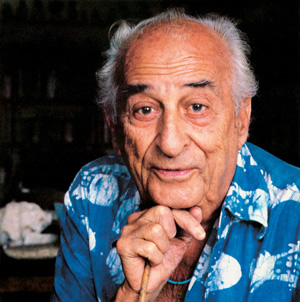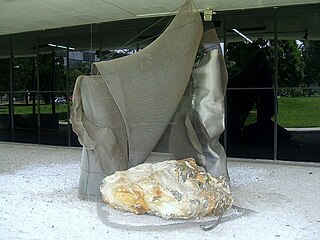Brígida Baltar was a Brazilian visual artist. Her work spanned across a wide range of mediums, including video, performance, installation, drawing, and sculpture. She was interested in capturing the ephemeral in her artwork.

Héctor Julio Páride Bernabó was an Argentine-Brazilian artist, researcher, writer, historian and journalist. His nickname and artistic name, Carybé, a type of piranha, comes from his time in the scouts. He died of heart failure after the meeting of a candomblé community's lay board of directors, the Cruz Santa Opô Afonjá Society, of which he was a member.

Francisco Brennand, or Francisco de Paula de Almeida Brennand,, was a Brazilian painter and sculptor, best known for his work in ceramics.

Fayga Perla Ostrower was a Polish-Brazilian engraver, painter, designer, illustrator, art theorist and university professor.
Rico Lins is a Brazilian graphic designer, art director, illustrator and teacher.
Beto Shwafaty is a Brazilian conceptual artist, visual researcher and critic.
Lucas Simões is a Brazilian artist based in São Paulo.

Iole Antunes de Freitas is a Brazilian sculptor, engraver, and installation artist who works in the field of contemporary art. Freitas began her career in the 1970s, participating in a group of artists in Milan, Italy linked to Body art. She used photography. In the 1980s, she returned to Brazil, but abandoned the human body as mediator of her work, adopting the "sculpture body". The artist uses materials such as wire, canvas, steel, copper, stone, and water to create her works.
Waltércio Caldas Júnior, also known as Waltércio Caldas, is a Brazilian sculptor, designer, and graphic artist. Caldas is best known as part of Brazil's Neo-Concretism movement as well as for his eclectic choices in materials.
Miguel Ángel Rojas is a Colombian conceptual artist born in Bogotá in 1946. His work includes drawing, painting, photography, installations and video and is often related to the sexuality, the marginal culture, the violence and problems involved with drug consumption and production.
Gilvan Samico was a painter, teacher and Brazilian engraver of the Armorial Movement of graphic design.

Anna Maria Baldo Niemeyer was a Brazilian architect, furniture designer and gallery owner. The only daughter of Oscar Niemeyer, she worked with her father to design the civic buildings for Brasília, focusing primarily on interior spaces and decoration. When her father decided to make furniture to harmonize his structures with the design elements, she turned her interest to furniture designing. Her two most noted designs were the initial prototype called the "Alta" and the "Rio". In her later career, she ran an art gallery in Rio, which at one time was the only gallery in the city, and assisted in the creation of the Niterói Contemporary Art Museum.

Rosângela Rennó Gomes is a Brazilian artist who lives and works in Rio de Janeiro. Her work consists of photographic images from public and private archives that question the nature of an image and its symbolic value. With the use of photographs, installations and objects, she appropriates and sheds new light on an anonymous body of photographs and negatives found mostly in flea markets, family albums, newspapers and archives. Rennó's interest in discarded images and habit of collecting were decisive in establishing her work strategies.

Willys de Castro was a Brazilian visual artist, poet, graphic designer, industrial designer, stage designer and magazine editor. De Castro is best known for his "Active object" series and is considered to be a pioneer and founding contributor of the Neo-Concrete Movement.
Waldemar Cordeiro was an Italian-born Brazilian art critic and artist. He worked as a computer artist in the early days of computer art and was a pioneer of the concrete art movement in Latin America.
Geraldo de Barros was a Brazilian painter and photographer who also worked in engraving, graphic arts, and industrial design. He was a leader of the concrete art movement in Brazil, co-founding Grupo Ruptura and was known for his trailblazing work in experimental abstract photography and modernism. According to The Guardian, De Barros was "one of the most influential Brazilian artists of the 20th century." De Barros is best known for his Fotoformas (1946-1952), a series of photographs that used multiple exposures, rotated images, and abstracted forms to capture a phenomenological experience of Brazil's exponential urbanization in the mid-twentieth century.
Renata Lucas is a Brazilian artist.
Teresa Nicolao is a Brazilian artist, designer and film maker.
Mariannita Luzzati is a Brazilian visual artist from São Paulo, recognized for her extensive study of landscapes.
Tikashi Fukushima was a Japanese-Brazilian painter and printmaker. Considered one of the most important abstractionists in Brazil, Fukushima also produced several works in the field of figurativism throughout his career. The artist has received various positive reviews from numerous important art critics for both his abstractionist and figurative productions. Fukushima belongs to the pre-war immigrant generation, composed of common immigrants who, after several changes in their lives, awakened to the arts. His master was Tadashi Kaminagai, whom Fukushima saw as a mentor, but who had a different style of painting than the one he later developed. Tikashi's works have been presented in national and international exhibitions.









